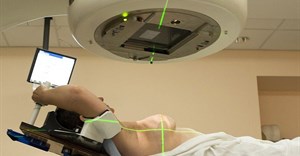New device delivers radiation therapy to specific tumour sites
The Moores UCSD Cancer Centre is one of the first medical facilities in the nation to offer patients this new form of breast conservation therapy, which combines surgery and radiation to treat breast cancer while preserving as much of the breast tissue as possible.
The UCSD team reported that a new technology called the SAVI™ applicator, which allows radiation to be delivered with precision to the cancerous site, avoiding healthy tissue, provides multiple benefits for patients, breast surgeons, and radiation oncologists.
Daniel Scanderbeg, Ph.D. gave the presentation, Early Experience with the SAVI for Multi-Catheter Single Entry High-Dose Rate Breast Brachytherapy on Tuesday, Nov 27.
"This technology allows treatment of breast cancer with less radiation exposure to normal tissues and a significantly shorter treatment duration," said Catheryn Yashar, M.D., assistant professor and chief of breast and gynaecological services in the UCSD Department of Radiation Oncology.
Breast conservation therapy includes lumpectomy - the surgical removal of the cancerous tissue within the breast plus tissue immediately around the tumour - followed by radiation. Traditionally, radiation therapy after a lumpectomy has involved treatment of the entire breast with external beam radiation. Known as whole breast irradiation, this approach exposes more healthy tissue and requires a much longer treatment course, with radiation delivered five times a week over a six-to-seven week period.
Partial breast radiation is an advancement in breast conservation therapy (lumpectomy plus radiation) as it treats a smaller amount of normal breast tissue and takes significantly less time to administer. Partial breast radiation is usually completed in approximately one week allowing women to more quickly resume their normal activities. Although early reports on partial breast irradiation are promising, the definitive study comparing it to whole breast radiation is currently underway by the National Surgical Breast and Bowel Project (NSABP).
The SAVI applicator is a single-entry, multi-catheter device that delivers partial breast irradiation. It was developed to expand the benefits of breast conservation therapy to a larger group of women, owing to its multi-catheter design that allows the precise delivery of radiation to avoid critical structures such as the skin, chest wall, and lungs, thus targeting more high-risk areas and sparing tissue that is more normal.
"Our early experience with SAVI has been excellent," said Yashar. "We were able to reproducibly treat the lumpectomy site and avoid healthy tissue such as the skin, chest wall and lungs because the radiation dose is precisely targeted. The device is also well tolerated by the patient and relatively easy for the physician to place."
Yashar and her colleagues report that treatment with the applicator is effective in multiple ways. SAVI can be inserted using local anaesthesia, is nearly painless to remove, and has produced outstanding early cosmetic results. Additionally, treatment planning is not significantly more difficult than other techniques and daily monitoring can be done with X-rays rather than full CT scans. This approach is more convenient and substantially reduces the patient's exposure to radiation.
The SAVI (Strut-Adjusted Volume Implant) applicator is made by Cianna Medical, Inc., a women's health company dedicated to the innovative treatment of early-stage breast cancer.









